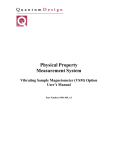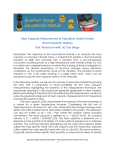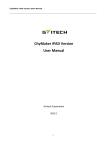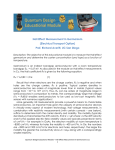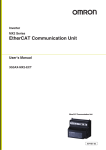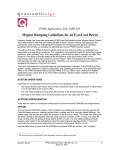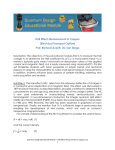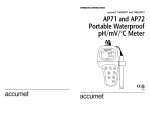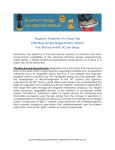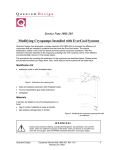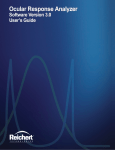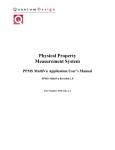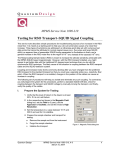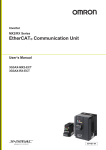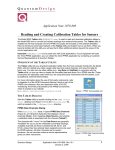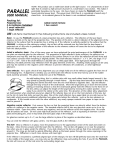Download Electrical Transport Option (ETO) User`s Manual
Transcript
Electrical Transport Option (ETO) User’s Manual Part Number 1084-700, A1 Quantum Design 6325 Lusk Boulevard San Diego, CA 92121 USA Technical support Fax (858) 481-4400 (800) 289-6996 (858) 481-7410 Second edition of manual completed September 2011. Trademarks All product and company names appearing in this manual are trademarks or registered trademarks of their respective holders. U.S. Patents Foreign Patents C O N T E N T S Table of Contents PREFACE Contents and Conventions ................................................................................................... vii P.1 P.2 P.3 P.4 Overview..................................................................................................................................... vii Scope of the Manual ................................................................................................................... vii Conventions in the Manual ......................................................................................................... vii Safety Guidelines and Regulatory Information.......................................................................... viii CHAPTER 1 Theory of Operation ............................................................................................................ 1-1 1.1 1.2 1.3 Introduction................................................................................................................................ 1-1 Overview of the Electrical Transport Option............................................................................. 1-1 Electrical Transport Option Measurement Types ...................................................................... 1-2 1.3.1 Resistance ......................................................................................................................... 1-2 1.3.1.1 Harmonic Detection ............................................................................................... 1-3 1.3.1.2 Hall Coefficient ...................................................................................................... 1-3 1.3.2 Current Voltage Curves .................................................................................................... 1-5 1.3.3 Differential Resistance Curves ......................................................................................... 1-5 CHAPTER 2 Installation............................................................................................................................ 2-1 2.1 2.2 Introduction................................................................................................................................ 2-1 Initial Installation of Hardware & Software............................................................................... 2-1 2.2.1 Install the ETO Module (4101-451) & ETO Head (4101-455) ........................................ 2-2 2.2.1.1 PPMS Hardware Installation .................................................................................. 2-2 2.2.1.2 VersaLab Hardware Installation............................................................................. 2-3 2.2.1.3 Dynacool Hardware Installation............................................................................. 2-3 2.2.2 Install the ETO Software .................................................................................................. 2-4 2.2.3 Configuring the Electronics .............................................................................................. 2-4 CHAPTER 3 Hardware.............................................................................................................................. 3-1 3.1 3.2 Introduction................................................................................................................................ 3-1 ETO Module & Head................................................................................................................. 3-1 3.2.1 Current Driver Electronics................................................................................................ 3-2 3.2.2 Preamplifiers..................................................................................................................... 3-4 3.3 Cables & Jumpers ...................................................................................................................... 3-5 3.4 Sample Pucks ............................................................................................................................. 3-5 Quantum Design PPMS ETO User’s Manual, 1084-700, Rev. A1 September 2011 iii Contents Table of Contents CHAPTER 4 Software ................................................................................................................................ 4-1 4.1 4.2 Introduction................................................................................................................................ 4-1 Overview of Electrical Transport Option Software ................................................................... 4-1 4.2.1 ETO Console .................................................................................................................... 4-1 4.2.1.1 Setup Tab ............................................................................................................... 4-1 4.2.1.2 Data File Tab.......................................................................................................... 4-3 4.2.1.3 Measurement Tab................................................................................................... 4-4 4.2.2 Electrical Transport Option Event Log............................................................................. 4-5 4.3 Electrical Transport Option Data Files ...................................................................................... 4-5 CHAPTER 5 ETO Measurements ............................................................................................................. 5-1 5.1 5.2 Introduction................................................................................................................................ 5-1 Sample Mounting....................................................................................................................... 5-1 5.2.1 4-Wire Mounting Configuration....................................................................................... 5-2 5.2.1.1 Hall Coefficient Mounting Configuration.............................................................. 5-2 5.2.2 2-Wire Mounting Configuration....................................................................................... 5-2 5.3 Sample Installation .................................................................................................................... 5-2 5.4 Immediate Mode Measurements................................................................................................ 5-3 5.4.1 Taking Resistance Measurements in Immediate Mode .................................................... 5-3 5.4.2 Current-Voltage Curves.................................................................................................... 5-5 5.4.3 Differential Resistance Curves ......................................................................................... 5-6 5.5 Sequence Measurements............................................................................................................ 5-7 5.5.1 ETO Resistance ................................................................................................................ 5-8 5.5.2 ETO dV/dI ........................................................................................................................ 5-9 5.5.3 ETO IV ........................................................................................................................... 5-10 5.5.4 New Data File ................................................................................................................. 5-11 iv PPMS ETO User’s Manual, 1084-700, Rev. A1 September 2011 Quantum Design Contents Table of Figures Figures Figure 1-1. Figure 1-2. Figure 1-3. Typical lead placement on a rectangular thin-film sample for (a) four-wire and (b) two-wire lead geometries .......................................................................................... 1-3 Typical lead placement on a rectangular thin-film sample for measurement of the Hall potential. The magnetic field would be applied normal to the sample surface. 1-4 Two graphs showing current and voltage waveforms (a) and the resulting I-V curve (b) for a diode measured using the ETO. ........................................................ 1-5 Figure 2-1. Activate the Electrical Transport Option using the Option Manager dialog box...... 2-4 Figure 3-1. Pictures of (a) the ETO module (CM-H) and (b) the remotely mounted ETO head (EM-QN)................................................................................................................... 3-1 Picture of the ETO module front panel showing the CH1 1 measured signal BNC (JH-1), CH1 drive signal BNC (JH-2), CH2 measured signal BNC (JH-3), CH2 drive signal BNC (JH-4), the head cable connector (JH-5), and the fan cable connector (JH-6). ...................................................................................................... 3-2 The equivalent circuit for ETO when drive feedback is disabled. The dashed line represents the current source equivalent circuit. ....................................................... 3-3 Pictures of the ETO option installed onto (a) a PPMS system (b) a VersaLab system and (c) Dynacool system. On the PPMS the head is mounted on the dewar using grip tape. VersaLab requires the use of the accessory mounting kit (4372-079)..... 3-5 Figure 3-2. Figure 3-3. Figure 3-4. Figure 4-1. Figure 4-2. Figure 4-3. Figure 4-4. Figure 4-5. Setup tab in the ETO Console Window .................................................................... 4-2 The Sample Installation Wizard Window ................................................................. 4-2 The Sample Configuration Window ......................................................................... 4-3 Data File Tab in the ETO Console Window ............................................................. 4-4 Measurement Tab in the ETO Console Window ...................................................... 4-5 Figure 5-1. Sample wiring examples. (a) Shows mounted both a 2-wire sample on channel 1 and a 4-wire sample on channel 1. (b) Shows mounted a 4-wire sample on channel 1 and a 4-wire Hall sample on channel 2..................................................... 5-2 The immediate mode AC Resistance Measurement Window................................... 5-4 The immediate mode IV measurement window. ...................................................... 5-5 The immediate mode differential resistance measurement window. ........................ 5-7 List of sequence commands available when ETO is active. ..................................... 5-8 The sequence command window for resistance measurements ................................ 5-9 The sequence command window for differential resistance measurements ........... 5-10 The sequence command window for IV measurements.......................................... 5-10 The sequence command window for creating a New Data File.............................. 5-11 Figure 5-2. Figure 5-3. Figure 5-4. Figure 5-5. Figure 5-6. Figure 5-7. Figure 5-8. Figure 5-9. Quantum Design PPMS ETO User’s Manual, 1084-700, Rev. A1 September 2011 v Contents Table of Contents Tables Table 2-1. A list of hardware components comprising the Electrical Transport Option for (a) PPMS and (b) VersaLab systems.............................................................................. 2-1 Table 3-1. Table 3-2. ETO current drive output impedance with feedback disabled .................................. 3-3 Preamp ranges and their associated gains for both 4-wire and 2-wire measurement modes ........................................................................................................................ 3-4 vi PPMS ETO User’s Manual, 1084-700, Rev. A1 September 2011 Quantum Design P R E F A C E Contents and Conventions P.1 Overview The preface contains the following info: P.2 • Section P.2 discusses the overall scope of the manual. • Section P.3 discusses the conventions of the manual. • Section P.4 discusses the safety guidelines for this option. Scope of the Manual This manual discusses the operation of the Electrical Transport Option (ETO), option hardware, option software, and general use of the option. This manual does not provide detailed information about the Versalab system or the MultiVu software application used to operate Versalab. This information can be found in the VersaLab User’s Manual. P.3 Conventions in the Manual File menu Bold text is used to distinguish the names of menus, options, buttons, and panels appearing on the computer screen. File >> Open The >> symbol indicates that you select multiple, nested software options. <Enter> Angle brackets distinguish the names of keys located on the PC keyboard. Note Text is set off in this manner to signal supplementary information about the current task; the information may primarily apply in special circumstances. Quantum Design PPMS ETO User’s Manual, 1084-700, Rev. A1 September 2011 vii Section P.4 Safety Guidelines and Regulatory Information Preface Contents and Conventions This symbol signals specific caution or conditions that could result in system damage, bodily harm, or loss of life. This symbol signals electrical hazards that could result in bodily harm, or loss of life. Used at all accessible 200-240 V power outlets. This symbol signals information on fusing. P.4 Safety Guidelines and Regulatory Information Before using this product, please read the entire content of this manual and observe all instructions, warnings and cautions. These are provided to help you understand how to safely and properly use the Electrical Transport Option (ETO). Quantum Design Inc. disclaims any liability for damage to the system or injury resulting from misuse or improper operation of the system. Please contact your Quantum Design representative for any service issues. This product is NOT user serviceable by the user. viii PPMS ETO User’s Manual, 1084-700, Rev. A1 September 2011 Quantum Design C H A P T E R 1 Theory of Operation 1.1 Introduction This chapter contains the following information: 1.2 • Section 1.2 gives an overview of the Electrical Transport Option. • Section 1.3 discusses the different measurements that are possible with ETO. Overview of the Electrical Transport Option The Quantum Design Electrical Transport Option (ETO) enables users to make several different types of transport measurements over a wide range of resistance values and sample types. The option contains two separate channels each with their own dedicated electronics to allow simultaneous, continuous resistance measurement of two different samples. Each channel’s electronics consists of a precision current source and voltage preamplifiers coupled to a Digital Signal Processor (DSP). Measurements are usually made by applying a sinusoidal AC drive current and measuring the AC voltage response. However, a special 2wire high resistance mode is available where an AC voltage is applied and the AC current response is measured with a current amplifier. The DSP is used to filter the AC response and pick out the portion of the response at the same frequency and phase as the drive signal. All other components of the signal are filtered out, eliminating frequency dependent noise, DC offsets, and instrument drift. The DSP can also calculate harmonic components of the measured signal. The current source has a minimum precision of 1 nA and a maximum current of 100 mA. It is capable of supplying both DC and AC current with frequencies from 0.1 Hz to 200 Hz. The preamplifiers consist of a high gain amplifier, a programmable gain amplifier, and a high impedance (current) amplifier. These three preamps, in conjunction with the current source, give the ETO a noise floor of 10 nΩ and allow measurement of resistances up to 5 GΩ. The Electrical Transport option is available on both PPMS and VersaLab systems. The ETO software is integrated into the MultiVu software application used to control and monitor the system hardware. You may use any MultiVu commands while working with the ETO. This software integration allows you to utilize MultiVu sequences to fully automate system operations and run a wide range of measurements without being present in the laboratory. Quantum Design PPMS ETO User’s Manual, 1084-700, Rev. A1 September 2011 1-1 Section 1.3 ETO Measure Types 1.3 Chapter 1 Theory of Operation Electrical Transport Option Measurement Types The Electrical Transport Option supports three types of measurements: 1.3.1 • Resistance • IV Curves • Differential Resistance Resistance The ETO is capable of both four-terminal and two-terminal resistance measurements. In the classic four-terminal geometry (4-wire mode), two leads pass a current through the sample and two separate leads measure the potential drop across a section of the sample. Ideally the voltage leads draw very little or no current. The current through the sample and the potential drop across the sample can therefore be known to a high degree of accuracy. Ohm’s law can then be used to calculate the resistance of the sample for the region between the two voltage leads. This geometry eliminates the effects of lead contact resistance from the measurement results. The resistance is calculated using Ohm’s law R= V I (1) where V is the measured potential drop across the sample and I is the current through the sample. Unlike the AC Transport measurement option available from Quantum Design, ETO does not calculate the resistivity. Since resistivity relies on sample specific parameters that may not be know, or not known accurately at measurement time, the option reports the resistance in units of Ohms. Resistivity can be calculated as follows, ρ= RA l (2) where R is the reported resistance, l is the voltage lead separation, and A is the crosssectional area through which the current is passed. It is important to configure the leads correctly in order to take full advantage of the instrument’s sensitivity. The current leads are typically located at the edge of the sample while the voltage leads lie between (Figure 1-1(a)). When current is passed through the sample an electric field is created. The voltage leads should be arranged such that they measure a potential drop across a region where the electric field lines are relatively straight. This is achieved by placing the voltage leads in-line with the current leads or by separating the voltage leads by a distance that is small compared to their distance from the current leads. It is also important for a true four-terminal measurement that the voltage and current leads do not contact the sample at the same point. Otherwise, the reported resistance will include the sample contact resistance. The lead geometry shown in Figure 1-1(a) works well for thin film sample with well defined dimensions. Other lead geometries may be used depending on the nature of the sample. For instance, when measuring a bar-shaped sample you may attach the current leads to conductive pads that contact the entire end of the bar and then make voltage leads that 1-2 PPMS ETO User’s Manual, 1084-700, Rev. A1 September 2011 Quantum Design Chapter 1 Theory of Operation Section 1.3 ETO Measure Types contact the sample in a line parallel to those ends. You are responsible for determining the best lead arrangement for your needs and for interpreting the resulting data. The Electrical Transport option is also capable of measuring large resistances using a twoterminal lead geometry (2-wire mode). This mode is typically used for resistances above 10 MΩ. In 2-wire mode the system applies a voltage across the sample and uses the high impedance amplifier to measure the current passing through the sample. The resistance is again calculated using Ohms law. Figure 1-1(b) shows a sample wired up in the two-terminal configuration. To achieve the best results the sample should be rectangular or bar-shaped with the leads far apart yielding a well-defined measurement region where the electric field line density is uniform. Lead and contact resistance can usually be ignored in this case as long as they are much less than the sample resistance. Figure 1-1. Typical lead placement on a rectangular thin-film sample for (a) four-wire and (b) two-wire lead geometries. 1.3.1.1 HARMONIC DETECTION The second and third harmonics of the measured response are reported in units of dB during a resistance measurement. The units of dB are referenced to the voltage of the fundamental response. This information can be related to nonlinearities in the sample but is often an indicator of the amount of noise present during a measurement. The second and third harmonic contribution is typically less than –50 dB for a good measurement. 1.3.1.2 HALL COEFFICIENT While it is not explicitly supported it is possible, with proper lead placement, to perform 4-wire Hall measurements using the Electrical Transport Option. When charged particles move perpendicular to a magnetic field a force is exerted on them perpendicular to both the field and the direction of particle motion. The force can be expressed as r r r F = qv × B (3) This transverse force can often cause charge carriers to build up on one edge of a sample leading to a potential difference across the sample. This potential difference is called the Hall potential, VH. The sign of the Hall potential generally indicates the sign of the charge carriers and the Quantum Design PPMS ETO User’s Manual, 1084-700, Rev. A1 September 2011 1-3 Section 1.3 ETO Measure Types Chapter 1 Theory of Operation magnitude of the potential is related to the density of charge carriers in the sample. The Hall coefficient, RH, describes these two properties and is defined as, RH = E H VH A = jB IlB (4) where EH is the Hall field, j is the current density, and B is the magnitude of the magnetic field. For a well defined geometry the current density is equal to I/A where I is the current and A is the sample cross-sectional area, and the Hall field is equal to VH/ l . Here l is the distance between a set of transverse voltage leads used to measure the Hall potential. It can be shown that the RH=(nq)-1, with n representing the number of charge carriers per unit volume in the sample and q representing the charge of the carriers. To measure the Hall potential arrange the voltage leads perpendicular to both the current and field directions. Figure 1-2 shows a thin-film rectangular sample wired up to detect the Hall potential. In this example the magnetic field would be applied normal to the sample surface. Using Eq. (1) you can rewrite Eq. (4) in terms of the resistance, R, reported by ETO. RH = RA lB (5) Accurately measuring the Hall potential can be difficult. To measure the potential difference due only to the Hall potential the voltage leads must be perfectly perpendicular to the bias field. If this is not the case the measured potential will include a component due to the longitudinal potential resulting from the sample resistance. The magnitude of the longitudinal potential is typically much larger than the Hall potential making even small errors in lead placement problematic. Both the Hall potential and the longitudinal potential are proportional to the bias current so the AC filtering technique employed by the ETO does not eliminate this effect. Figure 1-2. Typical lead placement on a rectangular thin-film sample for measurement of the Hall potential. The magnetic field would be applied normal to the sample surface. 1-4 PPMS ETO User’s Manual, 1084-700, Rev. A1 September 2011 Quantum Design Chapter 1 Theory of Operation 1.3.2 Section 1.3 ETO Measure Types Current-Voltage Curves The ETO is capable of measuring the current-voltage characteristics of any sample or device. In this mode the electronics applies a triangular excitation waveform and measures a response waveform. These two waveforms are combined to form the current-voltage curve for the device under test. The triangular excitation waveform always starts and ends at zero bias. Figure 1-3(a) shows both an excitation waveform and the response waveform for a diode plotted as a function of time. The nonlinear device characteristics are clearly visible in the response waveform. Figure 1-3(b) shows resulting I-V curve when the current waveform is plotted as a function of the voltage waveform. The ETO software allows you to select the number of quadrants to measure and in what order. The resulting curve will contain 256 points per quadrant. Both fourwire and two-wire IV curves can be measured. In the four-wire case a current excitation waveform is used and a voltage response waveform measured. In the two-wire case a voltage excitation waveform is used and a current response waveform measured. Figure 1-3. Two graphs showing current and voltage waveforms (a) and the resulting I-V curve (b) for a diode measured using the ETO. 1.3.3 Differential Resistance Curves The ETO is capable of measuring differential resistance as a function of bias current or voltage. This is achieved by applying a small AC excitation on top of a DC offset bias. The AC response is measured and used to calculate the differential resistance in the same manner as the standard resistance measurement when no DC bias signal is applied. The differential resistance is a direct measure of the first derivative of the IV curve at a given DC bias. This type of measurement is very useful for examining small nonlinearities in a given device. Quantum Design PPMS ETO User’s Manual, 1084-700, Rev. A1 September 2011 1-5 C H A P T E R 2 Installation 2.1 Introduction This chapter contains the following information: • 2.2 Section 2.2 lists the components of the Electrical Transport Option and describes the procedure for installation on PPMs and VersaLab systems. Initial Installation of Hardware and Software This section describes the procedures for the initial installation of the Quantum Design Electrical Transport Option (ETO) onto the PPMS and VersaLab systems. These procedures apply only to the first time you install and use ETO. Normal activation and use of the option is covered in Chapter 4. Note: If your system came from Quantum Design with ETO already installed you do not need to follow the procedures in this chapter. Refer to Chapter 4 for normal operation. Table 2-1 lists the components of the Quantum Design Electrical Transport Option. Please verify that you have received all the components before you begin the installation process. Table 2-1. A list of hardware components comprising the Electrical Transport Option for (a) PPMS, (b) VersaLab, and (c) Dynacool systems. (a) Quantum Design PPMS COMPONENT PART NUMBER ETO Module CM-H 4101-451 ETO Head EM-QN 4101-455 ETO Module Cable 3101-455-02 ETO Sample Cable 3101-456-01 ETO Fan Cable 3101-457-02 ETO Accessory Kit 4084-710 PPMS ETO User’s Manual, 1084-700, Rev. A1 September 2011 2-1 Section 2.2 Initial Installation of Hardware and Software (b) (c) 2.2.1 Chapter 2 Installation VERSALAB COMPONENT PART NUMBER ETO Module CM-H 4101-451 ETO Head EM-QN 4101-455 Accessory Mounting Kit 4372-079 ETO Module Cable 3101-455-01 ETO Sample Cable 3101-456-01 ETO Fan Cable 3101-457-01 ETO Accessory Kit 4084-710 DYNACOOL COMPONENT PART NUMBER ETO Module CM-H 4101-451 ETO Head EM-QN 4101-455 ETO Module Cable 3101-455-01 ETO Sample Cable 3101-456-01 ETO Fan Cable 3101-457-01 ETO Accessory Kit 4084-710 Install the ETO Module (4101-451) and ETO Head (4101-455) Use this section only if the ETO electronics have not been installed on your PPMS or VersaLab system. 2.2.1.1 PPMS HARDWARE INSTALLATION Refer to the PPMS User’s Manual for any issues regarding the PPMS. These installation instructions assume the Model 1000 tower and CAN bus have already been installed and tested. 1. Turn off the power to the Model 1000 CAN tower. 2. Verify that the power is off. All of the module LEDs should be dark. 3. Remove the cover plate for one of the rear, high-power, module bays and carefully insert the module into the bay. Gently finger-tighten the two mounting screws to secure the module in place. The module should now be flush with the other modules or cover plates. 4. The ETO head needs to be mounted close to the Grey Lemo connector at the back of the sample chamber. Determine the optimal mounting location for the ETO head and place the two pieces of self-adhesive grip tape on the PPMS dewar at this location. Make sure the head is close enough that the sample cable can easily reach the Grey Lemo without stressing the cable. 5. Press the ETO head onto the grip tape to secure it in place. Make sure the head is not touching any other dewar components. 6. Connect the ETO Module Cable (3101-455-02) and Fan Cable (3101-457-02) between the ETO module and the ETO head. 2-2 PPMS ETO User’s Manual, 1084-700, Rev. A1 September 2011 Quantum Design Chapter 2 Installation Section 2.2 Initial Installation of Hardware and Software 7. Turn on the power to the Model 6000 tower. Verify that both the PWR and COP indicator LEDs on the module are green. It may take up to 30 seconds for the module to boot and the LEDs to turn green. The COP LED will blink green until the option is activiated. 2.2.1.2 VERSALAB HARDWARE INSTALLATION Refer to the VersaLab User’s Manual for any issues regarding the VersaLab system. 1. Turn off the power to the VersaLab system. 2. Open the hood covering the CAN rack and verify that none of the modules already installed have power. All of the module LEDs should be dark. 3. Install the Accessory Mounting Bracket to the VersaLab frame using the two #6-32 screws, washers, and nuts provided in the Accessory Mounting Kit. 4. Remove the cover plate for the left most module bay as viewed when facing VersaLab. Carefully insert the module into the bay. Gently finger-tighten the two mounting screws to secure the module in place. The module should now be flush with the other modules or cover plates. 5. Mount the ETO Head to the accessory-mounting bracket using the hook and loop fastening tape on both the head and the bracket. Be sure to mount the head in the correct orientation. Note: When installed properly, the ETO head should not touch any of the mounting screws and should not interfere with the hood when closed. Adjust the location of the head if necessary. 6. Connect the ETO Module Cable (3101-455-01) and Fan Cable (3101-457-01) between the ETO module and the ETO head. 7. Turn on the power to the VersaLab system. Verify that both the PWR and COP indicator LEDs on the module are green. It may take up to 30 seconds for the module to boot and the LEDs to turn green. The COP LED will blink green until the option is activiated. 2.2.1.3 DYNACOOL HARDWARE INSTALLATION 1. 2. 3. 4. 5. 6. 7. Quantum Design Turn off the power to the PPMS DynaCool CAN rack located on the right side of the cryostat. The power switch for the CAN rack is located in back. Open the CAN rack door and verify that none of the modules installed have power. All of the module LEDs should be dark. Install the two pieces of Velcro provided with the system on the back panel of the CAN rack between the CAN rack and the cryostat shield. These should be in the center of the back panel high enough to ensure the ETO sample cable can reach the grey lemo connector. Remove the cover for the second or third module bay from the back and carefully insert the ETO module. Finger tighten the two mounting screws to secure the module in place. The module should now be flush with the other modules or cover plates. Mount the ETO head on the Velcro between the CAN rack and the cryostat with the D-shell connector facing the back of the PPMS DynaCool. Connect the ETO Module Cable (3101-455-01) and Fan Cable (3101-457-01) between the ETO module and the ETO head. Attach the ETO Sample Cable (3101-456-01) between the ETO head and the grey lemo connector. Turn on the power to the CAN rack. Verify that both the PWR and COP indicator LEDs on the module are green. It may take up to 30 seconds for the module to boot and the LEDs to turn green. The COP LED will blink green until the option is activated. PPMS ETO User’s Manual, 1084-700, Rev. A1 September 2011 2-3 Section 2.2 Initial Installation of Hardware and Software 2.2.2 Chapter 2 Installation Install the ETO Software Use the following instructions to install the VersaLab Electrical Transport Option software on your PC. (See the MultiVu User’s Manual for MultiVu installation instructions.) The installation wizard will install all of the option files in the C:\QDPPMS\ETOption\, C:\QDVersaLab\ETOption\, or C:\QDDynacool\ETOption directory for PPMS and VersaLab respectively. 1. Close all other applications prior to installing the ETO software. 2. Double click the ETO Installer.msi file to start the installation wizard. Follow the instructions on the screen to install the software. Note: Be sure to select the correct base system type, either PPMS or VersaLab, when prompted. 3. Verify that the ETO software is installed correctly by activating it within the MultiVu software. a. Open the MultiVu application software. b. Select Utilities>>Activate Option. c. In the Option Manager dialog box select Electrical Transport from the Available Options list and press the Activate button. d. Electrical Transport will move to the Active Options list inside the Option Manager. e. The Electrical Transport software will open the ETO Console window and the ETO Event Log window, confirming that the software was install correctly. Figure 2-1. Activate the Electrical Transport Option using the Option Manager dialog box. 2.2.3 Configuring the Electronics The ETO electronics are ready to use out of the box and do not require any calibration files on the PC. All of the calibration and configuration information is stored inside the module SROM. Contact your customer service representative with any problems associated with the calibration or SROM. 2-4 PPMS ETO User’s Manual, 1084-700, Rev. A1 September 2011 Quantum Design C H A P T E R 3 Hardware 3.1 Introduction This chapter contains the following information: 3.2 • Section 3.2 discusses the operation of the ETO electronics. • Section 3.3 discusses the cables and jumpers • Section 3.4 discusses the sample pucks ETO Module and Head The Electrical Transport Option electronics consists of the module (CM-H) and the remotely mounted head (EM-QN). The module contains a Digital Signal Processor (DSP) that performs all AC stimulus-response calculations and a secondary processor for post processing and communications. The remotely mounted head contains two sets of current drivers and preamplifiers to allow for simultaneous, independent resistance measurements on channel 1 and channel 2. Figure 3-1 shows the module and head enclosures. (a) (b) Figure 3-1. Pictures of (a) the ETO module (CM-H) and (b) the remotely mounted ETO head (EM-QN) To perform a basic transport measurement an AC drive signal is generated at the requested frequency by the DSP. The current driver board in the head receives the drive signal and converts it to a current that is applied to the sample. The preamplifier board in the head detects and amplifies the sample response signal and sends it back to the DSP for processing. The DSP calculates the inphase and out of phase components of the response signal as well as several harmonic amplitudes. Quantum Design PPMS ETO User’s Manual, 1084-700, Rev. A1 September 2011 3-1 Section 3.2 ETO Module and Head Chapter 3 Hardware The module (CM-H) contains four BNC outputs for use in monitoring the drive (JH-2 and JH-4) and response signals (JH-1 and JH-3) for both channel 1 and 2. The BNC labels are located on the module front panel as shown in Figure 3-2. The drive signal full-scale is 10 V. For example, on the 100 mA range, a 50 mA peak excitation current would generate a 5 V peak signal at the BNC. The response signal is monitored behind the preamplifiers. The response signal measured at the BNC needs to be divided by the total gain to obtain the voltage at the sample. Figure 3-2. Picture of the ETO module front panel showing the CH1 1 measured signal BNC (JH-1), CH1 drive signal BNC (JH-2), CH2 measured signal BNC (JH-3), CH2 drive signal BNC (JH-4), the head cable connector (JH-5), and the fan cable connector (JH-6). 3.2.1 Current Driver Electronics The current drivers in ETO employ active feedback to approximate an ideal current source. When the feedback is on, the current driver adjusts the applied potential to maintain a constant output current regardless of the sample and lead resistance. Figure 3-1 (b) shows the load lines for the current driver with feedback on. As the graph shows, the current is independent of the measured voltage across the sample. The driver behaves as a current source for potentials up to the 30 V compliance of the source. In this mode the current driver has high output impedance. This is the default operating mode and is desirable for most measurements and samples. When feedback is off, the drivers can be represented as a voltage source behind a source resistance. Figure 3-3 (a) shows the equivalent circuit when the feedback is turned off. In this case, the current passing through the sample is dependent on the sample and lead resistance. Figure 3-3 (c) shows the load lines for the current driver as a function of the measured sample voltage. In this configuration the sample current decreases with increasing sample voltage. If the sample or lead impedance is comparable or larger than the source impedance the actual current will be significantly lower than the requested current. ETO will correct for this discrepancy as best as possible and the corrected current will be reported in the data file. The corrected current will be a good approximation of the actual sample current in the limit that RLeads << RDrive. For systems with large lead resistance the current can be manually corrected as follows: I sample = I reported ⋅ R Drive R Drive + RLeads where RLeads is the resistance due to leads and sample contacts. Table 3-1 lists the nominal drive impedance for each current range when the drive feedback is disabled. 3-2 PPMS ETO User’s Manual, 1084-700, Rev. A1 September 2011 Quantum Design Chapter 3 Hardware Section 3.2 ETO Module and Head a) c) b) Figure 3-3. The equivalent circuit for ETO when drive feedback is disabled. The dashed line represents the current source equivalent circuit. Table 3-1. ETO current drive output impedance with feedback disabled. Current Range Drive Output Impedance 100 mA 100 Ω 10 mA 1 kΩ 1 mA 10 kΩ 100 uA 100 kΩ 10 uA 1 MΩ 1 uA 10 MΩ 100 nA 100 MΩ In most cases the electronics should be run with the drive feedback enabled. This will typically yield the most accurate measurement. However, it may be useful to disabled the feedback if you are measuring an IV curve on a sample with a non-linear current-voltage characteristic, such as a diode. With feedback off the IV curve of a diode will contain more points at lower bias currents when the device impedance is large. Quantum Design PPMS ETO User’s Manual, 1084-700, Rev. A1 September 2011 3-3 Section 3.2 ETO Module and Head 3.2.2 Chapter 3 Hardware Preamplifiers The ETO head contains a programmable-gain amplifier (PGA), a high-gain amplifier (HGA), and a high-impedance amplifier (HZA). The amplifiers used in a particular measurement are determined both by the measurement type and the range specified in the measurement window. Four-wire measurements will use the PGA and the HGA when needed while two-wire measurements will use the PGA and the HZA at all times. The HGA has a typical noise specification of 1 nV / Hz giving a noise floor of 10 nΩ for a 100 mA excitation. The HZA, by contrast, is a sensitive amp meter and is used to measure impedances above 10 MΩ. The gain of the preamplifiers is determined in each measurement by selecting the range in the preamp controls. The range is typically specified as a voltage. This can be interpreted as the maximum sample voltage the system can measure at the chosen range. The lower the voltage range the higher the total gain. In practice the system can measure up to 110% of the voltage specified by the range. If you do not know the impedance of your sample ahead of time, you can elect to autorange. In this case the system will automatically adjust the range based on the measured signal. Selecting autorange will delay the return of data while the system adjusts the gains to find the appropriate range. Table 3-2. Preamp ranges and their associated gains for both 4-wire and 2-wire measurement modes. 4-Wire Mode Preamp Nominal Range Module Gain Head Gain Total Gain 4V 1X 1X 1X 1.3 V 3X 1X 3X 0.4 V 1X 10X 10X 130 mV 3X 10X 30X 40 mV 1X 100X 100X 13 mV 1X 300X 300X 4 mV 3X 300X 900X 1.3 mV 1X 3,000X 3,000X 0.4 mV 3X 3,000X 9,000X 130 uV 1X 30,000X 30,000X 40 uV 3X 30,000X 90,000X 2-Wire Mode 3-4 Preamp Nominal Range Module Gain Head Gain Total Gain 400 nA 1X 1X 1X 130 nA 3X 1X 3X 40 nA 1X 10X 10X 13 nA 3X 10X 30X 4 nA 1X 100X 100X 1.3 nA 3X 100X 300X PPMS ETO User’s Manual, 1084-700, Rev. A1 September 2011 Quantum Design Chapter 3 Hardware Section 3.4 Sample Pucks If you are measuring a sample with impedance greater than 10 MΩ you will use the HZA and a 2-wire sample-mounting configuration. In this configuration ETO applies a voltage and measures the current through the sample. The preamp range is specified in Amps for these measurements. The measurement windows will automatically switch the drop down list to a selection of current ranges when the 2-wire configuration is chosen. 3.3 Cables and Jumpers The ETO option includes one 25-pin cable to connect the module to the remotely mounted head, one 2-pin cable to power the cooling fans on the head, and one 8-pin cable to connect the head to the sample chamber. The cable use and routing are shown in Figure 3-4. ETO kits intended for use on PPMSs are shipped with long length module and fan cables. ETO kits intended for use on VersaLab systems are shipped with short length cables. Both kits use the same sample cable to connect the head to the sample chamber grey Lemo. Additional sample cables are necessary when connecting ETO to one of the temperature options available on the PPMS. (a) (b) (c) Figure 3-4. Pictures of the ETO option installed onto (a) a PPMS system (b) a VersaLab system and (c) Dynacool system. On the PPMS the head is mounted on the dewar using grip tape. VersaLab requires the use of the accessory mounting kit (4372-079). 3.4 Sample Pucks ETO includes two sample pucks for mounting samples that interface with the VersaLab sample chamber wiring. The pucks have a mounted circuit board with labeled contact pads for convenient sample wiring on 3 channels. When using ETO, only channels 1 and 2 are used. Channel 3 may be used with other measurement options or other third-party electronics that you hook up to the base system. The gold plated contact pads on the puck are useful for either wire bonding or soldering. For more information regarding sample wiring refer to Section 5.2. Quantum Design PPMS ETO User’s Manual, 1084-700, Rev. A1 September 2011 3-5 C H A P T E R 4 Software 4.1 Introduction This chapter contains the following information: • Section 4.2 presents an overview of the ETO software including the ETO console. • Section 4.2.2 discusses the ETO status log. • Section 4.3 reviews how to create data files and contains descriptions of each data column contained within the file. 4.2 Overview of Electrical Transport Option Software 4.2.1 ETO Console Whenever the Electrical Transport Option is active the ETO Console window will be present within the MultiVu window. This window can be minimized but will only close when the option is deactivated. From the console window you can perform all basic system operations, such as sample installation, setting up data files, and running measurements manually in immediate mode. The ETO Console contains a Setup tab, Data File tab, and a Measurement tab. The functionality of each tab is described below. 4.2.1.1 SETUP TAB The Setup tab is the default tab for the ETO Console and is displayed when the option is initially activated. Figure 4-1 shows the Setup tab within the ETO Console. This tab is used to install or remove samples and enter information about the samples that will be entered into the data file. The Sample Installation Wizard button will launch a separate window for the wizard when pressed. This wizard will guide you through the steps necessary to open the sample chamber to either install or remove a sample. Figure 4-2 shows the Sample Installation Wizard window. The System Status panel displays the current system status and the Instructions panel displays information and guidance regarding each step of the wizard. The wizard does not execute any Quantum Design PPMS ETO User’s Manual, 1084-700, Rev. A1 September 2011 4-1 Section 4.2 Overview of Electrical Transport Option Software Chapter 4 Software commands when started and requires that the user press the Open Chamber button to initiate the installation procedure. Follow the instructions on the screen to install or remove a new sample. The Sample Properties button will launch a separate window to allow you to enter properties of the sample that you would like to store in the data file. This information is stored in the data file header. For more information regarding the ETO data files refer to Section 4.3. Figure 4-3 shows the Sample Properties window containing the Wiring, Sample 1 Info, and Sample 2 Info tabs. The Wiring tab is used to specify the wiring configuration used on each sample. It also lists the types of measurements that can be run with each configuration. The two Sample Info tabs allow you to enter sample specific information such as name, material, and dimensions. For more information regarding the wiring configuration refer to Section 5.2. Figure 4-1. Setup tab in the ETO Console window. Figure 4-2. The Sample Installation Wizard window. 4-2 PPMS ETO User’s Manual, 1084-700, Rev. A1 September 2011 Quantum Design Chapter 4 Software Section 4.2 Overview of Electrical Transport Option Software Figure 4-3. The Sample Configuration window. 4.2.1.2 DATA FILE TAB The Data File tab is used to specify the data file into which the ETO data is written. Pressing the Browse button will bring up a standard Windows file interface that allows you to specify a file name and location on the PC for the data file. You can use this window to either select an existing file or create a new file name. If a new data file name is selected the data file is not created immediately. Instead the file is created when the first data point is written to the file. The currently selected target file and its location are displayed in the Path and File Name fields. The Create new file version checkbox, when checked, will add a numeric suffix to the file name displayed if the file already exists. If this box is unchecked the option will append to an existing data file. The Sample Properties button is also contained in the Data File tab in the event the Setup tab is not used. The functionality for this button is identical to that on the Setup tab and you can enter information from either tab. The information contained in the Sample Properties window is written to the data file when it is first created. New sample information can be entered at any time before a new measurement is taken and the new file is created. The View button opens the selected data file and displays the data as a new graph in MultiVu. It will always open the file specified in the File Name field provided the file has already been created. Quantum Design PPMS ETO User’s Manual, 1084-700, Rev. A1 September 2011 4-3 Section 4.2 Overview of Electrical Transport Option Software Chapter 4 Software Figure 4-4. Data File tab in the ETO Console window. 4.2.1.3 MEASUREMENT TAB The Measurement tab is used to open the measurement window for the selected measurement. The radio buttons on the right indicate the measurement type selected and the display window gives an example of the type of data that can be collected. After you have selected the measurement type press the Launch Measurement button to bring up the immediate mode measurement window. While an immediate mode measurement window is active this tab is not active. The active measurement window must be closed prior to launching a different measurement window. 4-4 PPMS ETO User’s Manual, 1084-700, Rev. A1 September 2011 Quantum Design Chapter 4 Software Section 4.3 Electrical Transport Option Data Files Figure 4-5. Measurement tab in the ETO Console window. 4.2.2 Electrical Transport Option Event Log The ETO Event Log window is displayed when ETO is activated. This window displays highlevel hardware and software activity during ETO measurements. This log will also display warnings, errors, and informational messages generated since option activation. If you have a problem while a measurement is running, entries in the event log can help diagnose the problem. 4.3 Electrical Transport Option Data Files All of the data taken by the Electrical Transport Option is stored in a single data file. The file name and location can be set on the Data File tab of the ETO Console or within a sequence. For more information on changing the data file refer to Section 4.2.1.2. This section contains a list and description of each of the data columns as well as the measurement types that use the different data types. Data Type Units Description Resistance dV/dI IV Time Stamp s Time stamp associated with the row of data X X X Temperature K Sample Temperature X X X Field Oe Magnetic Field X X X deg Angle of the sample stage relative to the magnetic field X X X Sample Position Quantum Design PPMS ETO User’s Manual, 1084-700, Rev. A1 September 2011 4-5 Section 4.3 Electrical Transport Option Data Files Chamber Pressure Resistance Ch1/Ch2 Resistance Std. Dev. Ch1/Ch2 Phase Angel Ch1/Ch2 I-V Current Ch1/Ch2 I-V Current Ch1/Ch2 Frequency Ch1/Ch2 Averaging Time Ch1/Ch2 AC Current Ch1/Ch2 DC Current Ch1/Ch2 Voltage Ampl. (Ch1/Ch2) In phase Voltage Ampl. (Ch1/Ch2) Quadrature Voltage Chapter 4 Software Torr Pressure inside the sample chamber X X Ohms Measure resistance X X Ohms The standard deviation of the resistance X X X X deg X mA Wave form of the current X V Wave form of the voltage X Hz Excitation Frequency X X X s Actual averaging time X X X mA The peak amplitude of the AC drive excitation X X X mA The DC drive excitation V Magnitude of the voltage X X V The in-phase voltage amplitude X X V The out-of-phase voltage amplitude X X V The peak voltage of the AC drive X X X X X AC Voltage Ch1/Ch2 DC Voltage Ch1/Ch2 Current Ampl. (Ch1/Ch2) In Phase Current Ampl. (Ch1/Ch2) Quadrature Current Ch1/Ch2 V The maximum DC voltage in the channel X X X mA Magnitude of the current X X X V The in-phase current amplitude X X X X Gain 190000 X X 2nd Harmonic V X X 3rd Harmonic V X X ETO Status Code N X X X ETO Measurement Mode V X X X 4-6 mA The out-of-phase current amplitude Total gain = Module gain X head gain The in-phase voltage amplitude of the 2nd harmonic The in-phase voltage amplitude of the 3rd harmonic An encoded integer containing information on the current status of the ETO hardware Integer indicating the measurement type for the row of data PPMS ETO User’s Manual, 1084-700, Rev. A1 September 2011 X Quantum Design C H A P T E R 5 ETO Measurements 5.1 Introduction This chapter contains the following information: • Section 5.2 discusses how to mount samples on the sample pucks. • Section 5.3 discusses how to make measurements in immediate mode and in sequence mode. 5.2 Sample Mounting The Electrical Transport Option includes two resistivity pucks that mount into the sample chamber. Each sample puck has a circuit board around the perimeter with 12 pads organized into three channels. Each channel has 4 pads labeled I+, I-, V+, V- in the standard 4 wire resistance geometry. The circuit board has labels for each pad as well as the channel number corresponding to each group to avoid confusion during sample mounting. ETO uses the channel 1 and channel 2 pads. There is a space in the center of the puck for physically mounting your sample substrate onto the puck surface. For most measurements below room temperature Apeazon N-grease is adequate to secure your sample to the puck surface. However, more exotic mounting methods may be necessary for larger samples. The wiring configuration used for each sample depends on the type of sample you are measuring. The ETO electronics has a 4-wire standard mode for samples whose resistance is below 10 MΩ and a 2-wire high-impedance mode for samples whose resistance is 10 MΩ up to 5 GΩ. Both wiring configurations are discussed below along with mounting and wiring examples. Since the ETO has two independent sets of measurement electronics it is possible to wire up one sample in standard mode and the other in high-impedance mode. Note: How you wire up your sample determines what electronics you must use. You cannot switch back and forth between standard and high-impedance modes without physically changing the sample wiring. WARNING! Do not wire up both channels to the same sample as this may lead to errors in the reported resistance due to stray capacitance. Quantum Design PPMS ETO User’s Manual, 1084-700, Rev. A1 September 2011 5-1 Section 5.3 Sample Installation 5.2.1 Chapter 5 ETO Measurements 4-Wire Mounting Configuration To make a standard resistance measurement in 4-wire configuration you should mount your sample as shown in Figure 5-1(a) for the sampled wired to channel 2. The two current leads should be at the ends of your sample and the two voltage leads should be in line between the current leads. Ensure that the polarity of the voltage leads matches that of the current leads or the reported resistance will be negative. 5.2.1.1 HALL COEFFICIENT MOUNTING CONFIGURATION ETO can also be used to make Hall measurements. Figure 5-1(b) shows channel 1 wired for a standard resistance measurement and channel 2 wired for a Hall measurement. The wiring arrangement shown yields the proper sign for the Hall coefficient. It is important when wiring a Hall sample that the voltage contacts are at the same zero-field potential to avoid measuring longitudinal signal. This is usually achieved by making sure the voltage contacts are perpendicular to the current contacts. ETO does not support 5-wire Hall measurements. 5.2.2 2-Wire Mounting Configuration For samples whose resistance exceeds 10 MΩ the 2-wire configuration is necessary. In this case the sample is connected to the I+ pad and the V- pad as shown in Figure 5-1(a) channel 1. It is important that you use the I+ and V- pad or the measured resistance will have the wrong sign or value. Hall measurements are not possible in the 2-wire configuration. b) a) Figure 5-1. Sample wiring examples. (a) Shows mounted both a 2-wire sample on channel 1 and a 4 wire sample on channel 1. (b) Shows mounted a 4-wire sample on channel 1 and a 4-wire Hall sample on channel 2. 5.3 Sample Installation The sample installation wizard is accessible from the Setup tab on the ETO Console. You are encouraged to use this wizard as it automates the installation process and leaves the sample chamber in the proper state for temperature cycling. Pressing the Sample Installation Wizard 5-2 PPMS ETO User’s Manual, 1084-700, Rev. A1 September 2011 Quantum Design Chapter 5 ETO Measurements Section 5.4 Immediate Mode Measurements button will launch the wizard window, shown in Figure 4-2. Follow the instructions on the screen to install your sample. When prompted by the wizard install the sample puck using the puck extraction tool. (For more information on sample installation refer to either the PPMS or Versalab manual.) Pressing cancel at any time during the wizard will abort the wizard safely. Enter sample information after installing the sample puck into the sample chamber. Press the Sample Properties button to bring up the dialog window. Enter the wiring configuration for sample 1 and 2 on the wiring tab. Enter any other sample specific information you desire on the two sample tabs. This information will be entered into the header section of the data file. Switch to the Data File tab to select a new data file for your measurements. Press Browse to enter a new file name and location. Checking the Create New File Version checkbox will add a numeric suffix to the end of the file name if the file already exists. Press the View button to open the data file in MultiVu. Note: The data file is not created until a measurement is initiated. 5.4 Immediate Mode Measurements After the sample puck has been loaded you are ready to take measurements in immediate mode. At this point it is a good idea to make a few test measurements in immediate mode to ensure your sample is loaded properly. Open up a measurement window to perform the desired test measurements. The immediate mode measurement windows are accessible through the Measurement tab in the ETO Console. Select a measurement type and press the Launch Measurement button. The following sections describe the process of setting up each type of measurement. 5.4.1 Taking Resistance Measurements in Immediate Mode The AC Resistance Measurement window contains two identical sets of controls and indicators corresponding to channel 1 and channel 2. Use these blocks to define the measurement parameters and read the measurement results specific to each channel. A third section at the bottom of the window displays base-system information relevant to both channels. Figure 5-2 shows the resistance measurement window. To make a measurement enable one or both channels, set all of the measurement parameters, then press the Measure button at the bottom. Resistance measurements will run until both channels are finished. Make sure to check the Save Results to File checkbox if you want to save the data. Measurement results will be displayed in the bottom of the window. Take the following steps to run an immediate mode measurement. 1. Check the Enable Measurement checkbox corresponding to the channel(s) you would like to measure. 2. Select either 4-wire or 2-wire from the Sample Wiring drop down menu corresponding to the wiring configuration used when the sample was mounted. Quantum Design PPMS ETO User’s Manual, 1084-700, Rev. A1 September 2011 5-3 Section 5.4 Impedance Mode Measurements Chapter 5 ETO Measurements 3. Use the Amplitude text box to specify the peak AC amplitude of the sinusoidal excitation applied during the measurement. Make sure the excitation is not large enough to damage your sample. The Amplitude will have units of mA for 4-wire configurations and in V for 2-wire. 4. Select the excitation frequency from the Freq drop down menu. 5. Select the Range from the drop down menu or check the Autorange check box if you want the range to be determined for you. The Range will have units of volts for 4-wire configurations and amps for 2-wire. 6. Use the Averaging Time text box to specify the measurement time in seconds. 7. Use the Number of Measurements text box to specify the number of resistance points you would like the measurement to include. 8. Press the Measure button to start the measurement. Figure 5-2. The immediate mode AC Resistance Measurement Window. During the measurement the Measure button will read Stop. Press this button at any time to end the measurement. The measurement results will be displayed at the bottom of the window. The Resistance displays the resistance measured in Ω. The Phase Angle displays the phase angle in degrees between the excitation signal and the measured signal. The 2nd Harmonic and 3rd Harmonic display the amplitude of each harmonic in dB. At the very bottom of the window are displayed the Temperature, Magnetic Field, and Position of the samples inside the sample chamber. 5-4 PPMS ETO User’s Manual, 1084-700, Rev. A1 September 2011 Quantum Design Chapter 5 ETO Measurements 5.4.2 Section 5.4 Immediate Mode Measurements Current-Voltage Curves Current-voltage curves can be taken on only one channel at a time. Take the following steps to measure a current-voltage curve in immediate mode. 1. Select the radio button for Sample 1 or Sample 2 to select a channel. 2. Select either 4-wire or 2-wire configuration from the Sample Wiring drop down list. 3. Select the sweep frequency from the Frequency drop down list. 4. Use the AC Amplitude text box to specify the peak amplitude of the sweep. The AC Amplitude has the units mA with 4-wire configuration and V in 2-wire. 5. Make sure the Disable Drive Feedback box is un-checked. This feedback should only be disabled if you are measuring a sample with a highly non-linear I-V characteristic. See section XXXX for more details regarding the drive feedback. 6. Select the type of excitation waveform desired. You have the option of performing a fourquadrant sweep or a two-quadrant sweep in the positive or negative direction. 7. Use the IV Sweeps text box to specify the number of sweeps to average together to create the IV curve. 8. Select the Range from the drop down menu. 9. Press the Measure button to begin the measurement. Figure 5-3. The immediate mode IV measurement window. While the measurement is being performed the Measure button will display Stop. Press this at any time to abort the current measurement. The status bar at the bottom of the window will display the measurement progress. When the status bar is full the IV curve will be available in the data file. Quantum Design PPMS ETO User’s Manual, 1084-700, Rev. A1 September 2011 5-5 Section 5.4 Immediate Mode Measurements 5.4.3 Chapter 5 ETO Measurements Differential Resistance Curves Differential resistance curves, like IV curves, can only be performed on one channel at a time. This measurement applies a small AC excitation and measures the differential resistance at various DC bias points. Take the following steps to measure a differential resistance curve in immediate mode. 1. Select the radio button for Sample 1 or Sample 2 to select a channel. 2. Select either 4-wire or 2-wire configuration from the Sample Wiring drop down list. 3. Select the AC frequency from the Frequency drop down list. 4. Use the DC Amplitude text box to specify the maximum value of the DC sweep. 5. Use the Steps/Quadrant text box to specify the number of DC steps per quadrant of the DC sweep. 6. The Step Size will be filled in automatically using the previously entered information. If you prefer, you can enter the step size and the steps per quadrant will be recalculated. 7. Select the DC sweep quadrants by dragging the start and stop cursors around on the sweep graph. 8. If the sweep does not start at zero bias, select the Ramp to Starting Point check box to ramp the DC bias to the starting value prior to starting the measurement. 9. Use the AC Amplitude text box to specify the amplitude of the AC excitation used to measure the differential resistance. This value should be less than the DC sweep amplitude. 10. Select the Range from the drop down menu. 11. Use the Averaging Time text box to specify how long to average each data point. 12. Use the Settling Time text box to specify how long in milliseconds to wait after each DC step before beginning each new resistance measurement. 100 ms is usually adequate. 13. Press the Measure button to begin measuring the curve. 5-6 PPMS ETO User’s Manual, 1084-700, Rev. A1 September 2011 Quantum Design Chapter 5 ETO Measurements Section 5.5 Sequence Measurements Figure 5-4. The immediate mode differential resistance measurement window. While the measurement is being performed the Measure button will display Stop. Press this at any time to abort the current differential resistance measurement. The status bar at the bottom of the window will display the measurement progress. When the status bar is full the dV/dI curve will be available in the data file. 5.5 Sequence Measurements A sequence can be used to run a series of measurements sequentially or to change other system properties while measuring, such as temperature or magnetic field. Any number of measurement commands or system commands can be run from within a sequence. Figure 5-5 shows the list of sequence commands available in MultiVu when ETO is active. All ETO specific commands are listed under Measurement Commands >>Electrical Transport. Note: For detailed information about creating and editing sequence files and for a discussion about all standard sequence commands, refer to the PPMS or VersaLab User’s Manual. Quantum Design PPMS ETO User’s Manual, 1084-700, Rev. A1 September 2011 5-7 Section 5.5 Sequence Measurements Chapter 5 ETO Measurements Figure 5-5. List of sequence commands available when ETO is active. 5.5.1 ETO Resistance Figure 5-6 shows the sequence command window for the resistance measurement. This window contains the same controls as the immediate mode window. Follow the same steps outlined in Section 5.4.1 to specify the measurement parameters. When you are finished press the OK button and the measurement command will appear in the sequence window. Since this command allows simultaneous measurements on both channel 1 and 2 it is possible for the two channels to have different measurement times. This can be caused by either very different averaging times or by selecting different numbers of points to measure on each channel. In this case the sequence will wait for both channels to finish measuring before moving on to the next sequence command. 5-8 PPMS ETO User’s Manual, 1084-700, Rev. A1 September 2011 Quantum Design Chapter 5 ETO Measurements Section 5.5 Sequence Measurements Figure 5-6. The sequence command window for resistance measurements. 5.5.2 ETO dV/dI Figure 5-7 shows the sequence command window for differential resistance measurements. Follow the same steps outlined in Section 5.4.3 to specify the measurement parameters. When you are finished, press the OK button and the measurement command will appear in the sequence window. As with the immediate mode, the sequence command for differential resistance can only perform measurements on one channel at a time. To measure both channels requires two sequence commands. Quantum Design PPMS ETO User’s Manual, 1084-700, Rev. A1 September 2011 5-9 Section 5.5 Sequence Measurements Chapter 5 ETO Measurements Figure 5-7. The sequence command window for differential resistance measurements. 5.5.3 ETO IV Figure 5-8 shows the sequence command window for the IV curve measurements. Follow the same steps outlined in Section 5.4.2 to specify the measurement parameters. When you are finished press the OK button and the measurement command will appear in the sequence window. As with the immediate mode the sequence command for IV curves can only perform measurements on one channel at a time. To measure both channels requires two sequence commands. Figure 5-8. The sequence command window for IV measurements. 5-10 PPMS ETO User’s Manual, 1084-700, Rev. A1 September 2011 Quantum Design Chapter 5 ETO Measurements 5.5.4 Section 5.5 Sequence Measurements New Data File Figure 5-9 shows the sequence command window to select or create a new data file within a sequence. Insert this command whenever you need to switch files, such as between measurements of different types. Press the Browse button to open the file dialog and select the file. Selecting the Create New File/Version radio button will create a new file with the name specified or add a numeric suffix if the file already exists. Selecting the Append to File radio button will add the data to an existing data file. Figure 5-9. The sequence command window for creating a New Data File. Quantum Design PPMS ETO User’s Manual, 1084-700, Rev. A1 September 2011 5-11














































